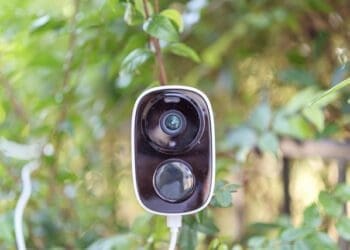As we step into an era of smart homes, we’re witnessing a revolution in home security. The SmartThings alarm system is at the forefront of this change, offering a blend of cutting-edge technology and user-friendly features. We’ve seen how this innovative system is transforming the way we protect our homes, providing peace of mind and advanced security options at our fingertips.
With the SmartThings app, we can now monitor and control our home security from anywhere, making it an essential part of the modern smart home ecosystem.
In this article, we’ll explore the ins and outs of the SmartThings alarm system and its role in enhancing home security. We’ll walk you through the setup process, highlight its smart features, and show you how it integrates with other devices in your home.
From motion sensors to the alarm panel, we’ll cover everything you need to know to get started. We’ll also discuss how this system works with other SmartThings devices and even third-party products like Konnected alarms, giving you a comprehensive look at the future of home security.
Understanding SmartThings Security

The evolution of home security has come a long way since its humble beginnings. We’ve seen a remarkable transformation from simple measures to sophisticated systems that leverage cutting-edge technology. In ancient times, people relied on moats, drawbridges, and even geese to protect their homes .
The first burglar alarm, invented in 1853, used electromagnets to ring a bell when a door or window opened . It wasn’t until the late 1960s that video technology became more accessible, marking the birth of modern home security .
As technology advanced, so did our approach to safeguarding our homes. The 1980s saw a significant increase in the adoption of home security systems, with companies lowering upfront installation fees to focus on monthly monitoring services . However, these early systems had limitations – they were hardwired, difficult to install, and vulnerable to tampering .
The introduction of WiFi in 1997 revolutionized the home security industry . It enabled wireless transmission of video streams and eliminated the need for complex wiring. This shift made installation easier and significantly reduced overall costs . The 2000s brought remote monitoring capabilities, allowing us to keep an eye on our homes from anywhere .
How SmartThings transforms your home protection
SmartThings has taken home security to a whole new level. It provides a cohesive platform for IoT devices to communicate and work together, creating smarter living solutions . At the heart of this system is the SmartThings Cloud, which handles complex automations, maintains device health, and allows us to access our devices and automations remotely through the SmartThings app .
One of the key features that sets SmartThings apart is Smart Home Monitor – an integrated home monitoring solution . It allows us to receive alerts and take action when unexpected events occur, such as unwanted entry, motion detection, smoke, fire, or leaks .
If you enjoy the reading!!! I have other content related to this article. Click here
With the latest Hub version and a connected camera, we can even get instant alerts with accompanying video clips, providing visual confirmation of what’s happening in our homes .
Core components of the SmartThings Alarm System
The SmartThings Alarm System comprises several essential components that work together to provide comprehensive home security:
- SmartThings Hub: The new Hub enables video streaming and has a battery backup that lasts up to 10 hours . It can also run certain functions locally, improving performance and continuing to operate even without an internet connection .
- Sensors: The system includes a variety of sensors, such as door/window sensors and motion detectors . These have been redesigned to be smaller and more esthetically pleasing, blending seamlessly into our home decor .
- Smart Home Integration: SmartThings allows us to integrate various smart home devices, including smart lights, thermostats, and locks . This integration transforms our security system into a sophisticated smart home command center.
- Mobile App: The SmartThings app gives us complete control over our security system from anywhere with an internet connection .
By combining these components, SmartThings creates a robust, flexible, and user-friendly home security solution. It’s not just about protecting our homes; it’s about creating a smarter, more connected living space that adapts to our needs and provides peace of mind.
Installation and Setup Process

Setting up our SmartThings alarm system is a straightforward process that we can complete in just a few steps. Let’s walk through the essentials to get our smart home security up and running.
Hardware requirements
To start, we need a SmartThings hub, which serves as the central command center for our smart home devices. The latest hub version comes with some impressive features, including video streaming capabilities and a battery backup that lasts up to 10 hours . This ensures our system continues to function even during power outages, providing uninterrupted protection.
We’ll also need various sensors, such as door/window sensors and motion detectors. These have been redesigned to be smaller and more esthetically pleasing, blending seamlessly into our home decor . For those of us with pets, it’s worth noting that some PIR (Passive Infrared) sensors might need to be pet-friendly, especially if we have larger animals. It can be challenging to find PIRs that won’t detect animals weighing over 40kg (about 90 pounds) .
Connecting devices to your SmartThings hub
Once we have our hardware, it’s time to connect our devices to the SmartThings hub. Here’s a simple guide to get us started:
- We open the SmartThings app on our phone. Remember, we’ll need a Samsung Account for this .
- In the app, we tap the “Devices” tab, then hit “Add” (look for the plus sign) .
- If our device uses Bluetooth, we can tap “Scan nearby” at the bottom of the screen. Alternatively, we can scan a device’s QR code if it has one .
- For devices that aren’t automatically detected, we can add them manually. We select “Add” next to Samsung devices for Samsung products or “Add” next to Partner devices for other brands .
- From there, we follow the on-screen instructions to connect our device to SmartThings .
For Samsung smart appliances, we might need to press a button on the appliance itself to enable its smart features and complete the connection .
Configuring security zones and modes
With our devices connected, we can now set up our security zones and modes. SmartThings offers two types of modes:
- Location modes: These control actions for the house as a whole. The default modes are “home,” “away,” and “night,” but we can add others as needed .
- Security modes: These are specifically for the alarm system. The three values are “disarmed,” “armed stay,” and “armed away” .
We can use SmartThings routines to automatically change these modes based on various triggers. For example, we could set up a routine that switches the house to “night” mode 30 minutes before sunset every day .
To enhance our system’s functionality, we can integrate it with other platforms. For instance, we can use Alexa routines to turn on a virtual switch in SmartThings, which then triggers a mode change using a SmartThings routine . This allows for more complex automations and better integration with other smart home ecosystems.
By following these steps, we’ll have a robust, flexible, and user-friendly home security solution that adapts to our needs and provides peace of mind.
Smart Features for Enhanced Protection

We’ve seen how the SmartThings alarm system is revolutionizing home security, and now it’s time to explore the smart features that make it stand out. These features not only enhance our protection but also give us greater control and peace of mind.
Real-time alerts and notifications
One of the standout features of the SmartThings alarm system is its ability to keep us informed in real-time. If an alarm or detector goes off, we’ll know instantly because we’ll receive an alert . This immediate notification allows us to take quick action, whether we’re at home or away.
SmartThings offers two types of notifications: traditional notifications that appear in our Notification panel and activity notifications that show up in the SmartThings app . We can manage both types of notifications to customize what we see and when we see it.
But what if we want to go beyond simple push notifications? Some users have explored creative ways to use SmartThings for more comprehensive monitoring.
Remote monitoring and control
With SmartThings, we have the power to monitor and control our home security system from anywhere. This remote access is a game-changer for home security.
We can arm or disarm our system remotely using the SmartThings app. There are three main options:
- Arm (away): We use this when we’re away and our home is unoccupied.
- Arm (stay): This is perfect for when we’re home but still want protection, like when everyone’s asleep.
- Disarmed: We use this when we don’t want any alarms or alerts to go off .
What’s even more convenient is that we can set up automations to arm or disarm our system automatically . This means we don’t have to remember to set the alarm every time we leave the house or go to bed.
AI-powered threat detection
The integration of artificial intelligence (AI) in the SmartThings ecosystem takes our home security to the next level. While not specifically designed for security, the AI features in various SmartThings-compatible devices can contribute to a safer home environment.
For instance, the AI Energy Mode uses AI to keep track of usage patterns and power consumption of our appliances . While this is primarily an energy-saving feature, it can also alert us to unusual activity in our home, which could indicate a security issue.
Samsung SDS has introduced an AI service platform called FabriX that enables the rapid and convenient application of generative AI to enterprise work systems . While this is currently more focused on business applications, it shows the potential for AI integration in future SmartThings security features.
As we look to the future, we can expect even more advanced AI-powered threat detection in our SmartThings alarm systems. These could include features like automatic threat identification and AI-enabled malware analysis, which are becoming increasingly important in the face of evolving cyber threats .
By combining real-time alerts, remote control, and AI-powered features, the SmartThings alarm system provides us with a comprehensive and intelligent approach to home security. It’s not just about detecting threats; it’s about giving us the tools to respond quickly and effectively, no matter where we are.
Integrating with Your Smart Home Ecosystem

We’ve found that one of the biggest advantages of using the SmartThings platform is its ability to integrate seamlessly with a wide variety of smart devices. This integration capability allows us to create a truly connected and automated home environment.
Compatibility with other smart devices
SmartThings works with an extensive range of connected devices, including lights, cameras, locks, thermostats, and more . We can easily connect and control these devices through the SmartThings app, which serves as a central hub for our smart home ecosystem .
To check if a device is compatible with SmartThings, we can visit the SmartThings website or use the SmartThings app itself. The app has a feature that allows us to check device compatibility when we’re adding new devices . It’s worth noting that SmartThings supports many third-party smart devices, expanding our options beyond Samsung-branded products .
I am glad you are enjoying this content… I have other articles related to this topic… Click Here
Voice control options (Alexa, Google Assistant)
One of the most convenient features of the SmartThings system is its compatibility with popular voice assistants like Google Assistant and Amazon Alexa. This integration allows us to control our SmartThings devices using just our voice .
To set up voice control, we first need to set up our voice-enabled device in the manufacturer’s app . Then, we can link our SmartThings account with Google Assistant or Amazon Alexa. Once linked, we can control permitted SmartThings devices with voice commands .
For example, with Google Assistant, we can say things like “Hey Google, turn off the living room lights” or “OK Google, set the thermostat to 72 degrees.” Similarly, Alexa can be used to control light bulbs, switches, thermostats, locks, and even check the status of motion and contact sensors .
Creating comprehensive home automation scenarios
Where SmartThings really shines is in its ability to create complex automation scenarios. We can go beyond basic “if A then B” rules and create sophisticated automations that include OR, UNLESS, and WHILE conditions .
For instance, we might want to set up a rule that only triggers if a door is open AND there’s motion in the room AND we’re not home. This level of complexity isn’t available in many low-cost home automation systems, but SmartThings makes it possible .
We can also create SmartThings Scenes for different scenarios like “Good Morning,” “Goodbye,” and “Good Night” . These scenes can automate multiple actions across various devices, making our daily routines smoother and more efficient.
For even more advanced automations, we can use third-party tools like SharpTools, which offers both free and premium tiers with additional features . This allows us to create truly comprehensive home automation scenarios tailored to our specific needs and preferences.
Conclusion
The SmartThings alarm system is causing a revolution in home security, blending cutting-edge technology with user-friendly features to provide peace of mind. Its ability to integrate with a wide range of smart devices, along with its powerful automation capabilities, makes it a standout choice for those looking to create a truly connected home. The system’s real-time alerts, remote monitoring, and AI-powered features give users unprecedented control over their home security, whether they’re at home or away.
As we look to the future, the SmartThings ecosystem is set to play an even bigger role in our daily lives. Its ongoing development and integration with new technologies promise to make our homes not just safer, but smarter and more efficient. While there’s still room for growth, particularly in AI-powered threat detection, the SmartThings alarm system is already a game-changer in the world of home security, offering a glimpse into the future of smart living.
FAQs
1. Has ADT SmartThings been discontinued?
Yes, ADT SmartThings has been discontinued. As of June 1, 2021, the ADT SmartThings Home Security and Safety devices, including the Security Hub, Detectors, and Alarms, as well as the optional 24/7 professional monitoring service from ADT, are no longer operational.
2. How can I use SmartThings as a security system?
To use SmartThings as a security system, begin by opening the SmartThings app and tapping on the Life tab. Swipe to find and tap on Home Monitor. After reviewing the information provided about the SmartThings Home Monitor, tap Next. Choose your desired options, which could include Security, Smoke, or Leaks, and then follow the instructions displayed on the screen to complete the setup.
3. Is there a monthly fee associated with using SmartThings?
No, there is no monthly fee or subscription required to use SmartThings. However, purchasing compatible devices is necessary to effectively utilize the system.
4. Can Alarm.com be integrated with SmartThings?
Yes, Alarm.com can be integrated with SmartThings. Once integrated, two switches will appear under Things in your SmartThings app: one labeled Arm Away and the other Arm Stay. Activating either switch will trigger the corresponding Arm action.






















































